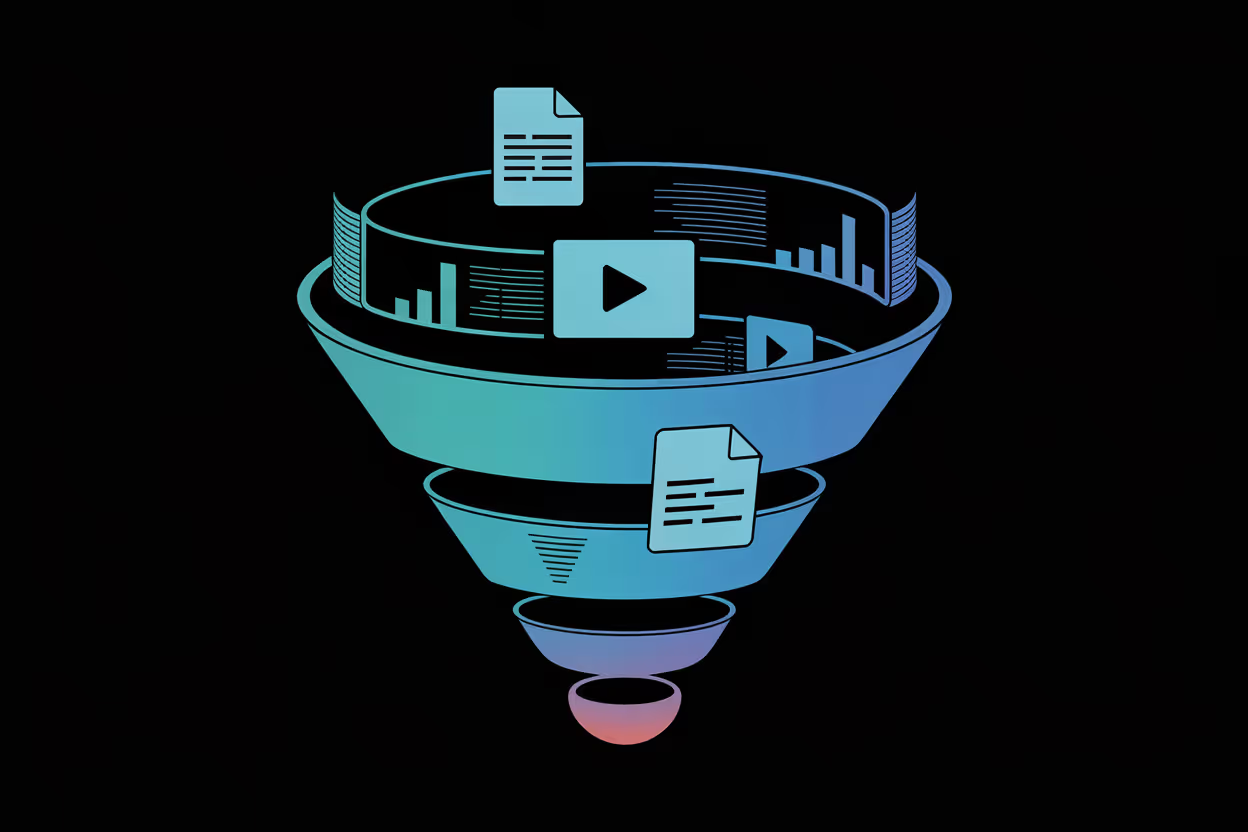Most B2B websites fail because they speak to everyone and connect with no one. Your engineering firm's website might list every service you offer, but does it actually help a manufacturing plant manager understand why they should work with you? Your construction company might showcase beautiful project photos, but does your content guide prospects through their buying journey?
Here's a stark reality that should grab your attention: B2B buyers now spend about 70% of their entire journey researching online before they ever talk to your sales team. They're forming opinions, eliminating options, and often making decisions before you even know they exist. If your website content doesn't meet them where they are, you're invisible during the most critical part of their buying process.
The good news is that strategic content can change everything. When you understand what your buyers need at each stage of their journey, you can create content that guides them naturally toward choosing you. This isn't about writing more blog posts or stuffing keywords into your pages. It's about building a content strategy that turns your website into a trusted advisor that works around the clock.
You're about to learn how to create content that actually meets buyers where they are. In this article, we will:
- Walk through each stage of the buyer's journey
- Explore what works for each phase
- Show you how to build a content machine that generates qualified leads consistently
The companies that get this right often see their qualified leads double within a year.
Understanding Your B2B Buyer's Journey
The Three Stages That Matter
Every B2B buyer goes through three distinct stages, and each one requires different content.
Awareness Stage
During the awareness stage, buyers realize they have a problem that needs solving. Maybe a construction company notices their project management is getting chaotic, or a manufacturer discovers their quality control processes are outdated. They know something's wrong, but they're not sure what to do about it yet.
Consideration Stage
The consideration stage is where buyers start exploring their options. They understand their problem and now they're researching different ways to solve it. That construction company might be comparing project management software versus hiring a consultant versus reorganizing their internal processes. They're not ready to buy anything yet, but they're actively learning about potential solutions.
Decision Stage
Finally, the decision stage arrives when buyers know what type of solution they want and they're comparing specific vendors. Now that construction company is looking at three different project management consultants, checking references, and trying to figure out which one fits their needs and budget best. They're ready to make a purchase, but they need reassurance they're making the right choice.
Why B2B Is Different from B2C
B2B buying is nothing like consumer purchasing, and your content strategy needs to reflect that difference. Here are three distinct differences to consider.
Longer Sales Cycles
Sales cycles in B2B often stretch from 3–12 months, sometimes longer for complex industrial equipment or enterprise software implementations. Your content needs staying power and depth to support prospects through these extended timelines.
Multiple Stakeholder Influences
Multiple people influence every B2B purchase decision. Research shows that 6–10 people typically get involved in B2B buying decisions, especially for significant investments.
Your content needs to speak to the:
- Plant manager worried about disruption
- CFO concerned about ROI
- Engineer focused on technical specifications
Each person needs different information to feel confident moving forward.
High-Stakes Buying Decisions
The stakes are also dramatically higher in B2B. A bad restaurant choice ruins one meal, but a bad vendor choice can disrupt operations for months or cost hundreds of thousands of dollars. B2B buyers need much more reassurance, proof, and detail before they'll risk their reputation on a recommendation. They're not just spending money; they're putting their professional credibility on the line.
The Content Gap Most B2B Sites Have: Lack of Middle-Stage Content
Most B2B websites make the same mistake: they focus almost entirely on decision-stage content like product specs, service descriptions, and case studies. While this content matters, it only helps buyers who already know exactly what they want. Everyone else bounces because they're not ready for that level of detail yet.
The middle of the funnel gets ignored even more often. Companies rarely create content that helps buyers compare different approaches or understand implementation challenges. This consideration-stage content is where you build trust and establish expertise, yet most B2B sites have nothing to offer buyers in this critical phase. Without it, prospects disappear to competitors who do a better job of education and guidance.
Example: When Product-First Homepages Fall Short
Durham Manufacturing offers an example of a manufacturing website homepage that leans heavily on products but provides little educational value. Their page is minimal and jumps straight into selling, giving buyers no context or guidance to help them understand their problem and determine what they need.
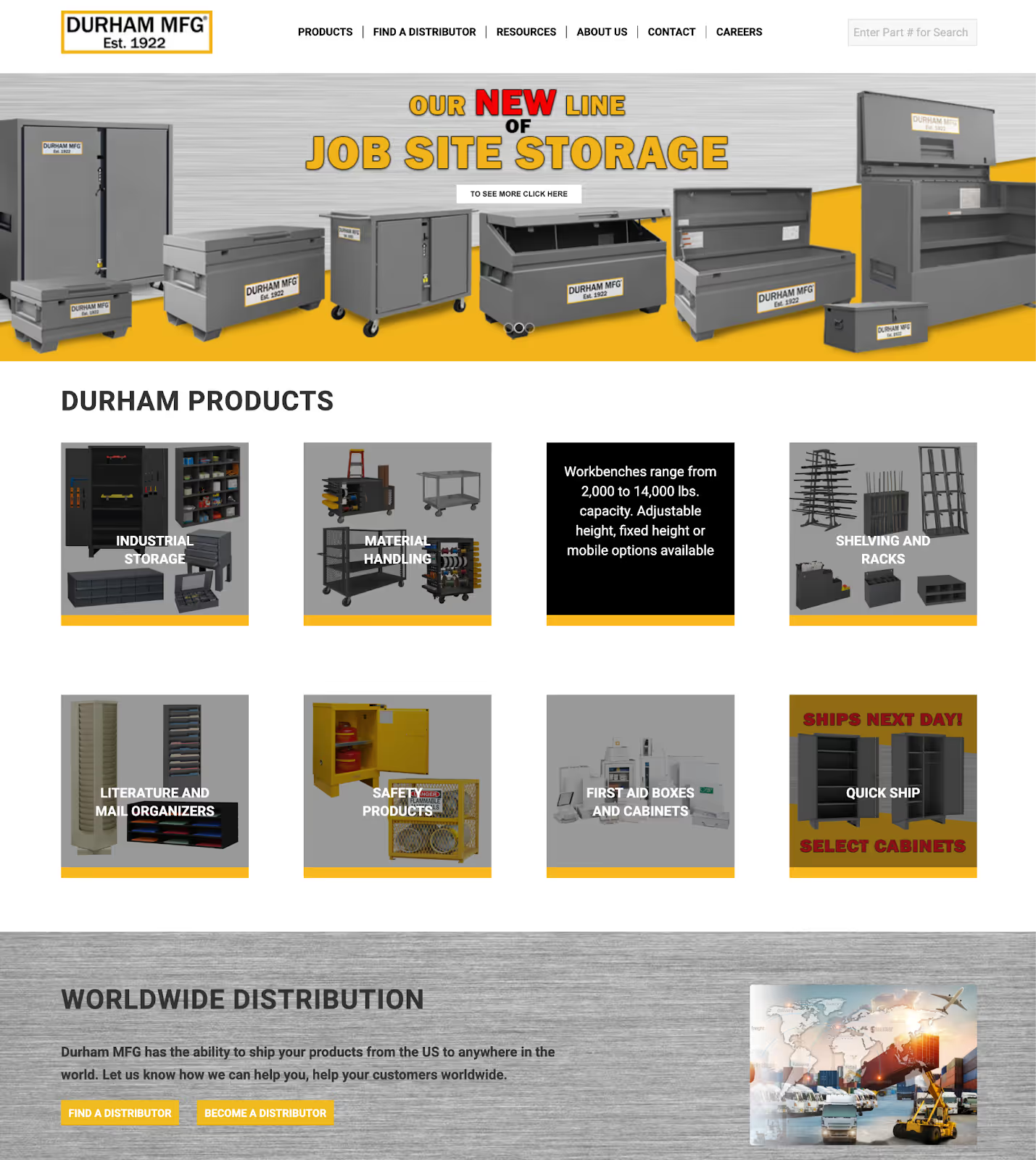
Without content that builds awareness and supports early-stage decision-making, prospects have no clear path to move deeper into the funnel.
Related Resources:
- B2C vs B2B Website Design: Key Differences That Impact Conversion
- B2B Buyer Journey Mapping: Building Websites That Convert
- B2B Website Navigation: Structure That Guides Complex Buyers
Awareness Stage: Help Them Understand the Problem
What Your Prospects Need Right Now
Buyers in the awareness stage aren't looking for vendors; they're looking for understanding. They need education about their problem, not a sales pitch about your solution. A manufacturer dealing with quality control issues wants to understand why defects are increasing, not read about your consulting services yet. They need validation that their problem is real and that other companies face similar challenges.
Define and Validate the Problem
Think about providing a problem definition and validation first. You can do this by:
- Helping them understand the scope and impact of their challenge
- Sharing industry insights and trends that explain why this problem is happening now
- Offering "you're not alone" reassurance that lets them know this is a solvable problem that successful companies have overcome
Content Types That Work
Educational Blogs
Educational blog posts that address specific pain points perform exceptionally well during the awareness stage. Write about the challenges your prospects face, not the solutions you provide. An engineering firm might write about "Why Construction Projects Go Over Budget" instead of "Our Project Management Services." The focus stays on the problem, building trust without selling.
Industry Trend Reports and Problem/Solution Guides
These types of guides and reports also resonate strongly with buyers. Trend reports and problem/solution pieces position you as an expert who understands the broader context of their challenges. "What is..." explainer content helps buyers understand terminology and concepts they're encountering.
Data-Driven Posts
Statistical posts that quantify problems give buyers ammunition to build internal support for finding a solution. Adding clear takeaways helps prospects connect the statistics to real business impact.
Establishing Thought Leadership
Executive perspectives on industry challenges build credibility quickly. When your CEO writes about the future of manufacturing automation or your head engineer discusses infrastructure challenges, you're showing deep expertise. This isn't about promoting your company; it's about demonstrating that you understand the industry's evolution and challenges at a strategic level.
Commentary on market trends and original perspectives set you apart from competitors who only talk about themselves. Even taking a controversial stance, when backed by evidence and experience, can establish your company as a thought leader worth following. The goal is building authority before selling, creating a foundation of trust that makes everything else easier.
How GE Vernova Guides Buyers With Thought Leadership Content
Global energy company GE Vernova features a “News” section in its main navigation menu, segmented into categories including “The Current” (featured news and media), “Press Releases,” and “Articles & Insights.” These resources give prospective buyers access to valuable thought leadership content, such as industry perspectives, trend analyses, and pieces addressing key challenges plaguing the industry.
Thought-provoking articles on topics like electrification and renewable energy reflect GE Vernova’s passion and position the company’s leaders as true industry experts and innovators. Adding this type of insight-driven content helps guide buyers who are still defining their needs and exploring potential partners and solutions.
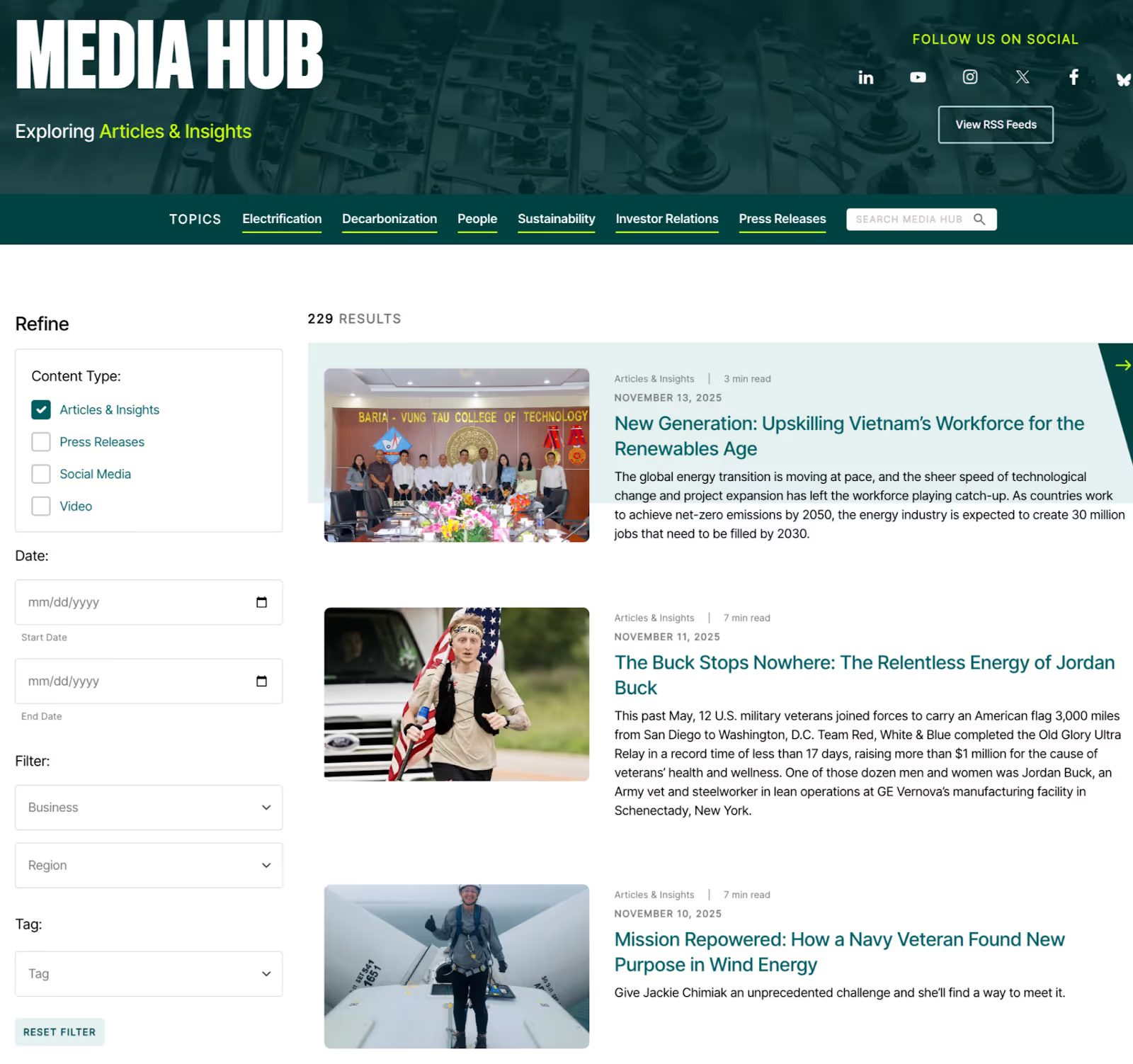
Long-Form vs Short-Form Decisions
Choosing between long-form and short-form content depends on your topic's complexity and your audience's needs. Complex technical topics often demand comprehensive guides that leave no question unanswered. A manufacturer researching lean manufacturing principles needs depth, not a surface-level overview. These readers will invest 30 minutes in content that truly helps them understand their situation.
However, busy executives might prefer quick reads that hit key points efficiently. The key is offering both options and letting readers choose based on their preferences and available time. A comprehensive guide can be accompanied by a two-minute executive summary, serving different readers with different needs.
Writing Tips for Awareness Content
- Focus Relentlessly on Their Problems, Not Your Solution: Every paragraph should help your prospects understand their challenge better, not pitch your services.
- Use the Language They Use: Avoid internal jargon and industry acronyms that might confuse. If prospects call it "inventory management," don't write about "supply chain optimization" (even if that's technically more accurate).
- Use Data and Research to Deepen Understanding: Incorporate credible statistics, studies, or industry reports that validate their concerns and illustrate the true scope of the problem.
- Be Genuinely Helpful (Without Being Pushy About Your Services): The goal is to become a trusted resource prospects will return to when they're ready to explore solutions.
Email Nurturing at This Stage
Email nurturing during the awareness stage should feel educational, not promotional. Consider implementing:
- Newsletter Content: Create newsletters that explore industry challenges, share insights, and provide genuine value to keep you connected without seeming salesy
- Drip Campaigns: Establish drip campaigns that focus on problem awareness and education to gradually help subscribers understand their challenges more deeply
Segment Subscribers
Segment your email list based on which content people engage with most. Someone reading articles about quality control has different needs than someone focused on workplace safety. This segmentation lets you provide increasingly relevant content that moves them naturally toward the consideration stage.
Related Resources:
- B2B Lead Generation: Proven Strategies for Local Market Growth
- B2B Website Messaging Framework: Copy That Resonates
Consideration Stage: Show Them What's Possible
What Prospects Are Really Looking For
Prospects in the consideration stage have moved beyond problem identification. They're now actively researching how to solve their challenge, and they need specific information to evaluate their options. They want honest comparisons of different approaches, not just the one you're selling. A construction company evaluating project management improvements needs to understand the pros and cons of software versus consultants versus internal process changes.
Integration Insights
Implementation considerations matter enormously at this stage. Prospects need to understand what adopting a solution actually involves, like:
- How long does implementation take?
- What resources are required?
- What disruption should they expect?
Budget and resource requirements need to be clear, even if exact pricing isn't available yet. Buyers are trying to build a realistic picture of what change looks like.
Content Formats That Guide Decision-Making
Different content formats serve different purposes during consideration. Here is how key content formats guide your prospects toward a decision:
- Comparison Guides and Versus Pages: Help buyers understand the differences between approaches
- Solution Category Overviews: Explain the landscape of available options without pushing one particular choice
- Buyer's Guides: Walk through the evaluation process step by step, helping prospects ask the right questions
- Webinars and Educational Videos: Bring complex topics to life
- Interactive Tools and Calculators: Let prospects explore scenarios specific to their situation
Each format serves prospects who learn differently or who need different depths of information. The key is providing multiple ways for buyers to educate themselves according to their preferences.
How Rockwell Automation Supports Buyer Needs With Multiple Content Formats
Rockwell Automation’s “Tools” page showcases a wide variety of content formats, including product and solution briefs, case studies, webinar recordings, demos, and technical whitepapers. This robust resource library is segmented into categories like “Downloads” and “Literature Library” to guide prospects toward the most relevant content.
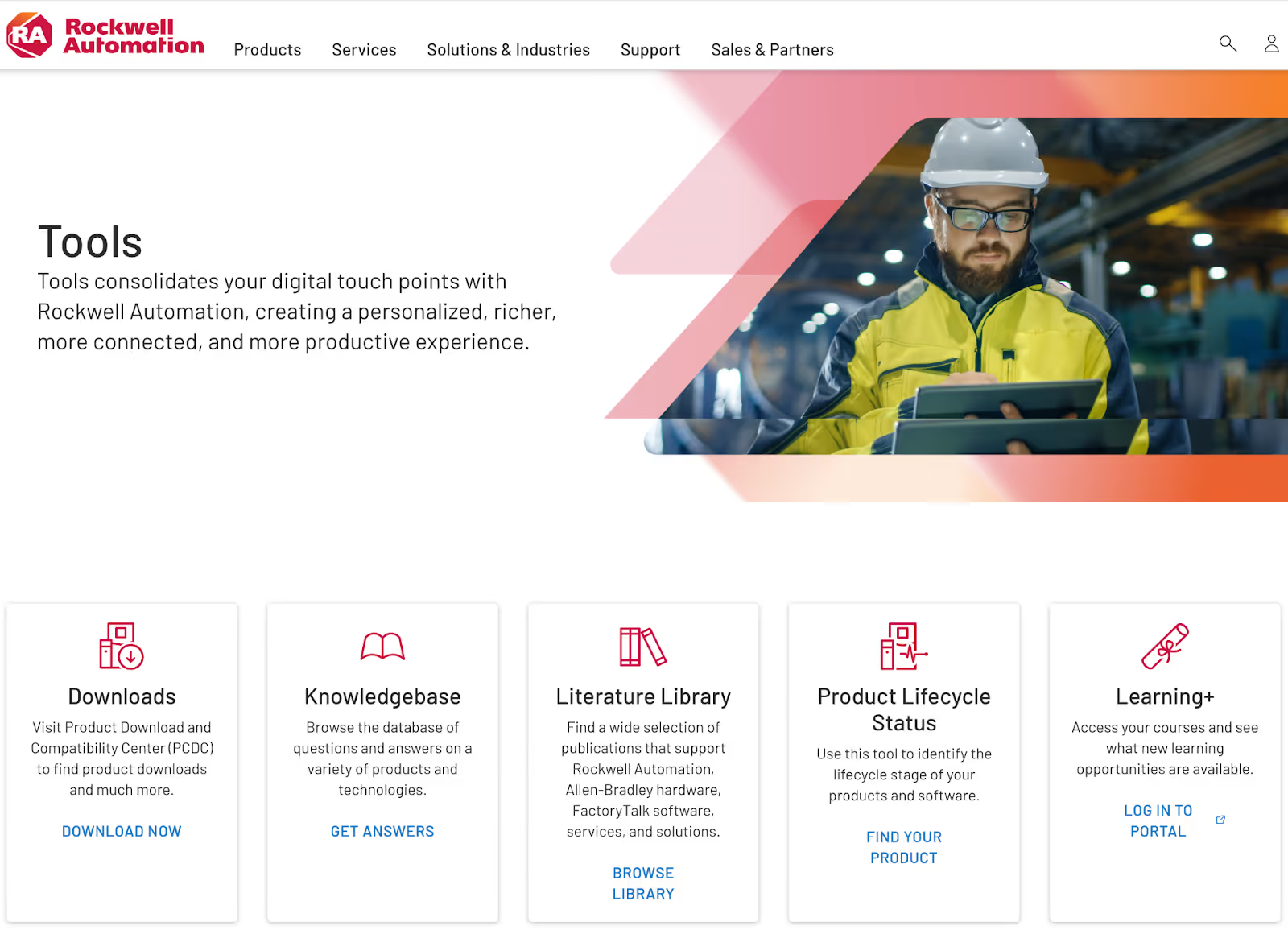
Product selection and configuration tools—like an integrated architecture builder and a proposal builder—offer real value to potential buyers, helping them explore options or tailor solutions to their unique environments.
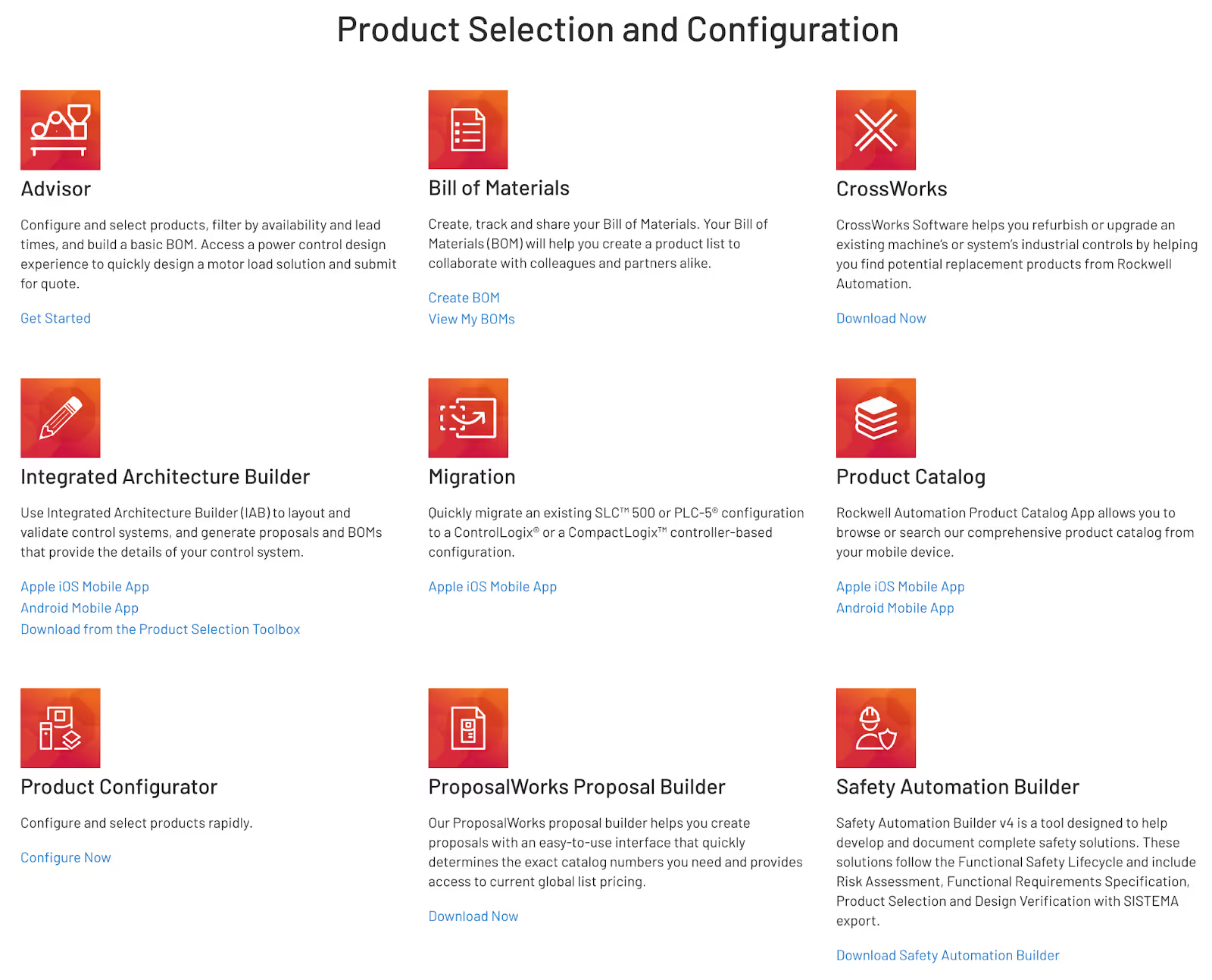
A library of documentation, drawings, and procurement specifications helps procurement teams validate whether a product meets their technical, compliance, and purchasing requirements.
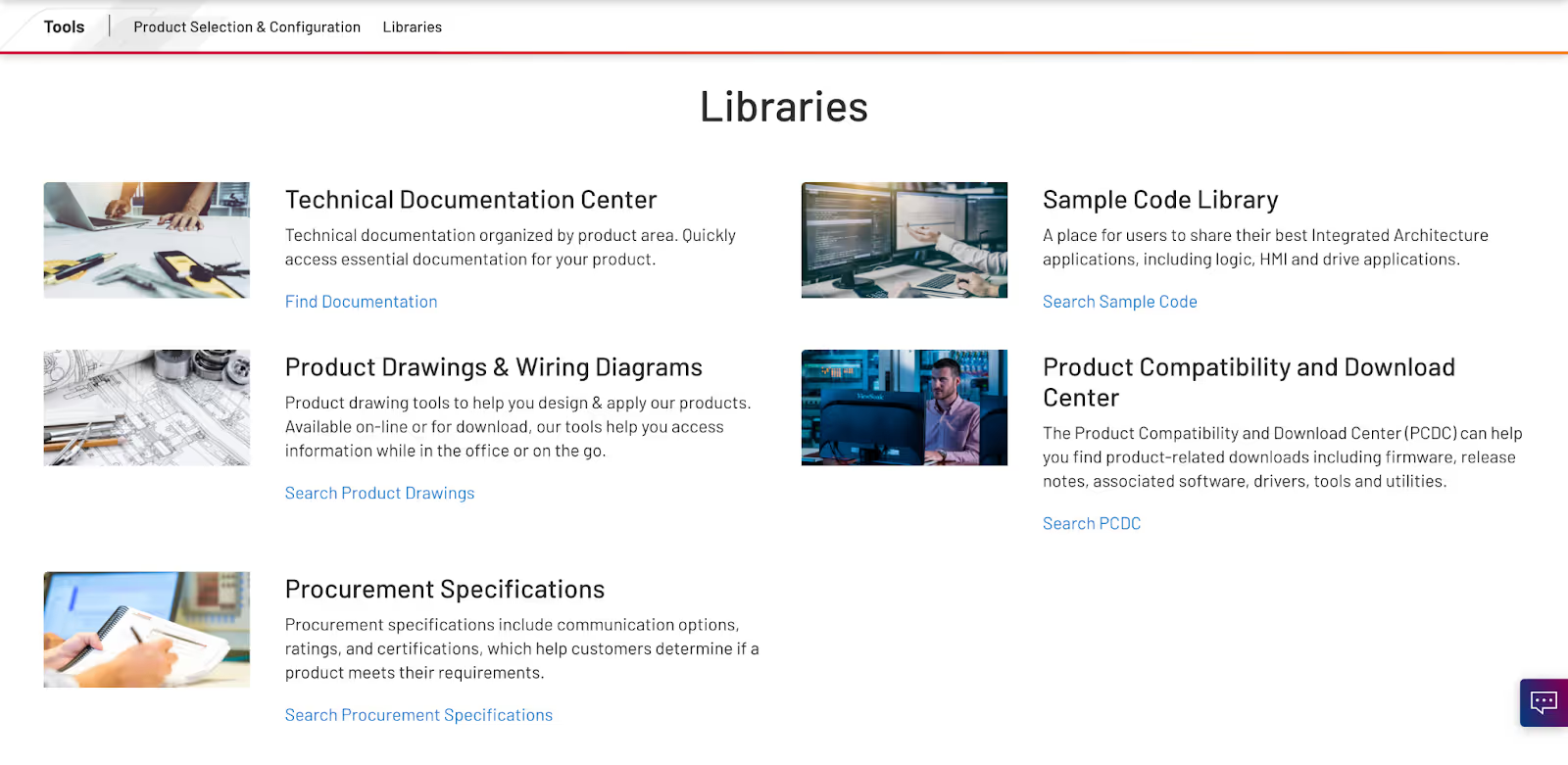
Diverse content formats like these appeal to different types of buyers by accommodating varied learning styles. Whether someone prefers hands-on tools, visual demos, or detailed technical documentation, this structure ensures every buyer can access information in the format that helps them move confidently toward a decision.
The Power of White Papers
White papers occupy a special place in B2B content strategy. They signal serious expertise and commitment to education.
When to Use White Papers
White papers beat other formats when:
- A topic requires deep exploration
- Technical complexity demands detailed explanation
- You need to present original research
White papers show you've invested real effort in helping buyers understand their options.
Best White Paper Topics
Topics that warrant white paper investment include:
- Industry-changing trends
- Complex technical comparisons
- Comprehensive implementation guides
Optimal White Paper Structure
The structure matters as much as the content. Effective B2B white papers:
- Follow a logical flow from problem to solution
- Include real data and examples
- Provide actionable insights readers can use regardless of whether they buy from you
To Gate or Not to Gate?
The decision to gate white papers behind a form depends on your goals. Gating generates leads but reduces reach. Consider your buyer's journey stage and the value you're providing. Early-stage educational content often works better ungated, building trust and reach. More specific, valuable content in the consideration stage might warrant gating. Whatever you choose, make sure your distribution strategy maximizes the investment you've made in creating the content.
Building Trust Through Content
Trust becomes paramount during the consideration stage. Here’s how you can establish trust and nurture relationships with website visitors.
Show Results Through Case Studies
Feature case studies with companies similar to your prospects. A mid-size manufacturer is more likely to trust a case study about another mid-size manufacturer than one about a Fortune 500 company.
Include specific details about:
- Challenges
- Solutions
- Results
For example, architecture, engineering, and construction firm Haskell shares case studies like “Controlling an Out-of-Control System” that reveal specific details and measurable results to build credibility. This case study outlines the client’s challenge that needed solving before walking through the process used to optimize and rebalance the client’s system–eliminating jams and improving throughput—in just two days.
The specificity of “two days” and language like “balanced and jam-free” gives concrete evidence of problem-solving speed and hands-on engineering capability, which matters to prospects seeking reliable, responsive contractors.

Remember: vague success stories don't build trust; specific, measurable outcomes do.
Validate Content Through External Authority
Expert interviews and quotes add third-party validation to your content. When an industry analyst or respected practitioner supports your approach, it carries more weight than self-promotion.
Be Transparent About Your Process
Share your methodology and process details openly. Address common objections upfront rather than hoping they won't come up. Transparency about limitations actually builds more trust than claiming perfection.
LinkedIn Content Strategy
Share Unique Insights
LinkedIn has become the primary social platform for B2B content distribution. Share snippets of longer content to drive traffic back to your website. A compelling statistic or insight from your latest white paper, posted with commentary, can generate significant engagement. Executive thought leadership posts from your company leaders humanize your brand and build personal connections with prospects.
Make It Easy to Promote Content Through Employees
Your company page needs a consistent content calendar that balances different types of posts. Employee advocacy programs, where team members share company content with their networks, can dramatically expand your reach. The key is making it easy for employees to share by providing them with suggested posts and clear guidelines about what's appropriate.
Email Marketing for Consideration
Offer Personalized Content Recommendations
Base your email nurture sequences on content downloads or previous engagement. This helps you provide increasingly relevant information and shows you’re paying attention to your prospects’ needs. Someone who downloads a comparison guide about project management approaches might receive follow-up emails with:
- Case studies
- Implementation timelines
- ROI calculators
The sequence should feel helpful, not pushy, gradually providing more specific information as prospects show continued interest.
Follow Up After Webinars
Webinar invitations give prospects a chance to learn interactively and ask questions. Follow-up emails after webinars should provide:
- Recordings
- Additional resources mentioned during the session
- Clear next steps for those ready to move forward
Related Resources:
- B2B Website Messaging Framework: Copy That Resonates
- Digital Marketing for Professional Services Firms: A Complete Guide
Decision Stage: Make It Easy to Choose You
What Buyers Need to Feel Confident
Buyers at the decision stage have chosen their solution type; now they're choosing a vendor.
Show Real Results
This isn't the time for vague marketing language. Decision-stage buyers need:
- Concrete proof you can deliver on your promises
- Specifics about how you've helped similar companies achieve measurable results
- Clear differentiation from competitors that highlights your strength as they compare final options side by side
Address Risks
Risk mitigation concerns dominate their thinking now. Answer questions like:
- What happens if the project goes sideways?
- What guarantees do you offer?
- How do you handle problems when they arise?
Clarify the Path Forward
They also need crystal clear next steps. After months of research, they're ready to move forward but need to know exactly how to begin. Any confusion or complexity at this point can send them to a competitor who makes it easier.
High-Converting Decision Content
Demonstrate Your Impact With Case Studies
Detailed case studies with ROI data serve as your most powerful decision-stage content. Go beyond surface-level success stories to provide:
- Specific metrics
- Timelines
- Challenges overcome
A manufacturing client doesn't just want to know you reduced costs; they want to know you reduced inventory carrying costs by 23% over 6 months while maintaining service levels.
Offer Supporting Resources
Additional decision-stage content includes:
- Product and Service Comparison Pages: Help buyers understand exactly what they're getting
- Implementation Timelines and Process Documentation: Show you've thought through every detail
- FAQ Pages: Address final concerns to prevent last-minute doubts from derailing deals
Each piece of content should reinforce that choosing you is the safe, smart decision.
Social Proof That Matters in B2B
Client Testimonials
Client testimonials carry weight when they include specific results and come from recognizable companies or individuals. A testimonial saying "Great service!" means nothing. One saying "Reduced our project completion time by 30% while maintaining our safety record" tells a story prospects can envision for themselves.
Trust Badges
Show you meet established standards and work with respected organizations by featuring trust badges like:
- Industry recognition
- Certifications
- Partnership badges
For example, HubSpot places trust badges directly beneath the hero content on their website homepage. Recognizable client logos show that their software is trusted by well-known and respected organizations, and a brief statement about their strong customer base and international reach reinforces credibility.

Further down the homepage, HubSpot also highlights that the company was voted #1 in hundreds of G2 reports, alongside badges for awards like “Most Implementable” and “Easiest Admin.” These awards signal to prospects that real users consistently rate HubSpot’s platform highly, offering external proof that the product is reliable and easy to adopt.

Trust signals like these help reduce perceived purchase risk by showing that others have successfully benefited from making the same decision.
Team Expertise
Team expertise and credentials matter more in B2B than almost anywhere else. Prospects want to know who they'll be working with and what qualifies them to solve complex problems.
Highlight relevant:
- Experience
- Certifications
- Track records
Show the actual people behind the company, not just corporate messaging.
Template Resources That Convert
Providing template resources demonstrates confidence and adds immediate value. These include:
- Proposal Templates: Help prospects understand what they should expect from vendors
- ROI Calculators: Let them build the business case internally
- Implementation Checklists: Show you understand the complexity of change management
- Comparison Matrices: Make it easy to evaluate options objectively
These resources serve two purposes:
- They genuinely help buyers make better decisions, building trust and reciprocity
- They shape the evaluation criteria in your favor by highlighting the factors where you excel
When you provide the template for comparison, you naturally emphasize the dimensions where you outperform competitors.
Removing Friction from the Decision
Make Actions Obvious
Clear calls-to-action on every page tell visitors exactly what to do next. But different buyers want different types of engagement. Some want a demo, others prefer a trial, and many just want an initial consultation. Provide multiple options and make each path crystal clear. A confused prospect rarely becomes a customer.
Communicate Next Steps Clearly
Transparent communication about next steps reduces anxiety about moving forward. Tell them exactly what happens after they fill out your form:
- How quickly will someone respond?
- What information should they prepare?
- What can they expect from the first conversation?
Easy-to-find contact information, including direct phone numbers and email addresses, shows you're accessible and ready to help.
Related Resources:
- B2B Website Conversion Optimization: A Data-Driven Approach
- Website ROI: How B2B Firms Calculate Payback
Creating Your Content Map
Start With Your Buyer Personas
Building effective content starts with understanding exactly who you're talking to.
Uncover Challenges
Go beyond basic demographics to understand job titles and daily responsibilities. You need to determine:
- What does a plant manager at a mid-size manufacturing facility actually do all day?
- What keeps them up at night?
- What metrics determine their success?
The more precisely you understand your buyers, the more relevant your content becomes.
Align Content With Buyer Goals
Goals and success metrics drive everything in B2B. Your content needs to connect with how your buyers are measured.
- If they're evaluated on equipment uptime → Focus on reliability and maintenance
- If cost reduction is their mandate → Emphasize efficiency and ROI
Understanding their challenges and pain points lets you write content that feels like you're reading their mind.
Learn Where They Seek Information
Information sources matter too. Do your buyers trust industry publications, peer recommendations, or analyst reports? Where do they go for information when they have a problem? Understanding their trusted sources helps you decide where to publish, who to partner with, and what formats to prioritize.
Map Content to Each Journey Stage
Start by listing the top questions buyers have at each stage of their journey:
- Awareness: What do they ask during initial problem recognition?
- Consideration: What comparisons do they need during consideration?
- Decision: What reassurances do they seek before signing a contract?
These questions become your content calendar foundation. Every piece of content should answer a real question your buyers have.
Evaluate Content Gaps
Identify content gaps in your current website by auditing what you have against what buyers need. You might discover you have 15 case studies but no comparison guides. Or plenty of problem-focused blog posts but no implementation resources.
Prioritize filling these gaps based on search volume and business value. A high-volume search term that brings qualified prospects deserves immediate attention.
The Hub-and-Spoke Model
The hub-and-spoke model organizes your content for both users and search engines.
- Hubs: Create pillar pages (hubs) for your main topics that provide comprehensive overviews
- Spokes: Build supporting content (spokes) that explores specific aspects in detail, all linking back to the main hub
Structure for Clarity
The hub-and-spoke model serves multiple purposes:
- It helps visitors navigate complex topics logically
- It builds topical authority that search engines reward
- It creates natural paths for buyers to go deeper into subjects that interest them
A visitor reading about manufacturing efficiency might start with your pillar page, then explore articles about specific efficiency techniques, implementation strategies, and relevant case studies.
Apply Strategic Internal Linking
Internal linking strategy ties everything together. Every spoke should link back to its hub and to related spokes where relevant. This isn't about gaming search engines; it's about helping readers find related information easily. When someone reads about inventory management challenges, a link to your article about solutions makes perfect sense.
Content Calendar Development
Balance is everything in content calendar development.
Create Content for All Stages
You will need:
- Awareness content to attract new visitors
- Consideration content to nurture them
- Decision content to convert them
A calendar weighted too heavily in any direction creates gaps in your buyer's journey. Plan for consistent coverage across all stages, adjusting based on your current pipeline needs.
Plan for Seasonal Content
Seasonal patterns and industry events create natural content opportunities. If your construction clients are busiest in summer, spring is when they plan and evaluate new approaches. Trade shows, industry reports, and regulatory changes all provide timely hooks for relevant content. Resource allocation requires realistic assessment of what you can consistently produce. Better to publish one great piece per week than four mediocre ones.
Related Resources:
- B2B Website Navigation: Structure That Guides Complex Buyers
- B2B Buyer Journey Mapping: Building Websites That Convert
Maximize Your Content Investment
Content Repurposing Strategies
Every piece of substantial content should generate multiple assets. A single webinar can become:
- A blog post recap
- Several social media clips
- An email series
- Quote graphics
- A podcast episode
This isn't about being lazy; it's about maximizing the value of your investment and reaching people who consume content differently. Some prefer video, others want written content, and many like bite-sized social posts.
Transform Case Studies
Case studies are particularly ripe for repurposing. That detailed success story can become:
- A one-page summary
- A presentation deck
- A video testimonial
- Social proof for proposal templates
- Website testimonials
Each format serves different purposes and reaches different audiences. The core story remains the same, but the presentation adapts to the medium and context.
Nurture Prospects With Email
Email series derived from pillar pages help you stay connected with prospects over time. Instead of sending them to read a 5,000-word guide, break it into digestible weekly emails. Each email provides value while moving readers closer to the complete understanding your pillar page provides. Social snippets from long-form content keep your social channels active without constant new creation.
Cross-Channel Distribution
Share on LinkedIn
LinkedIn deserves special attention in B2B content distribution. Your strategy should include both company page posts and employee advocacy.
Optimize Email Newsletters
Email newsletter optimization ensures your best content reaches subscribed audiences regularly. Don't just broadcast; segment your lists and customize content recommendations based on interests and behavior.
Explore Other Opportunities
Look beyond your own website to reach new audiences via:
- Podcast Guest Opportunities: Reach new audiences with your expertise
- Industry Publication Syndication: Extend your content's reach beyond your own channels
- Partner Content Collaboration: Create win-win situations where complementary businesses share audiences
The key is choosing channels where your specific buyers actually spend time, not trying to be everywhere at once.
Building Your Content Engine
A sustainable content engine requires clear workflow and defined responsibilities.
- Who identifies topics?
- Who writes?
- Who edits?
- Who publishes and promotes?
Without clear ownership, content creation becomes sporadic and inconsistent.
Ensure Quality With Checkpoints
Quality control checkpoints ensure everything meets your standards before publication. Be sure to review:
- Accuracy
- Brand voice consistency
- Technical SEO optimization
Monitor Content Performance
Performance tracking systems tell you what's working and what's not. Determine:
- Which topics generate the most engagement?
- What formats do your buyers prefer?
- Which channels drive qualified traffic?
Use data to iterate and improve continuously. Your content engine should get more efficient and effective over time, not just maintain the status quo.
Related Resources:
- B2B Website Design Best Practices: The Complete 2025 Guide
Measuring What Matters
Awareness Stage Metrics
Measuring awareness content requires patience and the right metrics, which include:
- Organic Traffic Growth: Shows whether you're attracting new visitors
- Time on Page/Scroll Depth: Indicate whether people actually read and engage with your content
- Email Newsletter Signups: Suggest visitors found enough value to want ongoing connection
These metrics matter more than immediate conversions for awareness content.
Monitor Engagement
Track which topics and formats generate the most engagement. A post about supply chain challenges that gets significant time on page and social shares tells you this resonates with your audience. Use these insights to create related content that goes deeper into successful topics.
Consideration Stage Metrics
Metrics to track in the consideration stage include:
- Return Visitor Rate: People coming back to read more content shows they see you as a valuable resource
- Pages Per Session: Indicates whether visitors explore related content or leave after one article
- Content Downloads/Webinar Attendance: Show serious interest in learning more
- White Paper Engagement: Reveals which topics truly matter to your audience
Monitor Content Progression
Track progression through your content. Ask:
- Do people who read comparison guides later view case studies?
- Which content paths most often lead to conversion?
Understanding these patterns helps you optimize the journey and identify content gaps that cause prospects to disappear.
Decision Stage Metrics
Conversion rate is the ultimate decision-stage metric, but dig deeper than overall percentages. Which specific pieces of content most often appear in the path to conversion? Demo requests, quote requests, and sales-qualified leads all indicate readiness to buy, but they might come from different content types. Understanding these patterns helps you invest in content that actually drives revenue.
Leverage Team Insights
Sales team feedback provides qualitative insights that numbers can't capture. Ask:
- Which content do they share most often?
- What questions do prospects ask that your content doesn't answer?
Regular communication between sales and marketing ensures your content serves the entire buyer's journey, not just the parts marketing sees.
Using Data to Improve
Monthly content audits and optimizations keep your content fresh and relevant. Every month, make time to:
- Update statistics
- Refresh examples
- Improve underperforming content based on what you've learned
A/B test headlines and CTAs to optimize existing content without starting from scratch. Sometimes a better headline can double an article's performance.
How GE Vernova Builds Confidence by Keeping Content Fresh
GE Veronova’s blogs all contain a “Last Updated” date to show readers exactly when each piece of content was last reviewed and refreshed. This practice of keeping content current helps create trust by signaling that the information is actively maintained, rather than outdated or forgotten. It also provides reassurance to prospects by showing them that the company is staying engaged with industry trends.
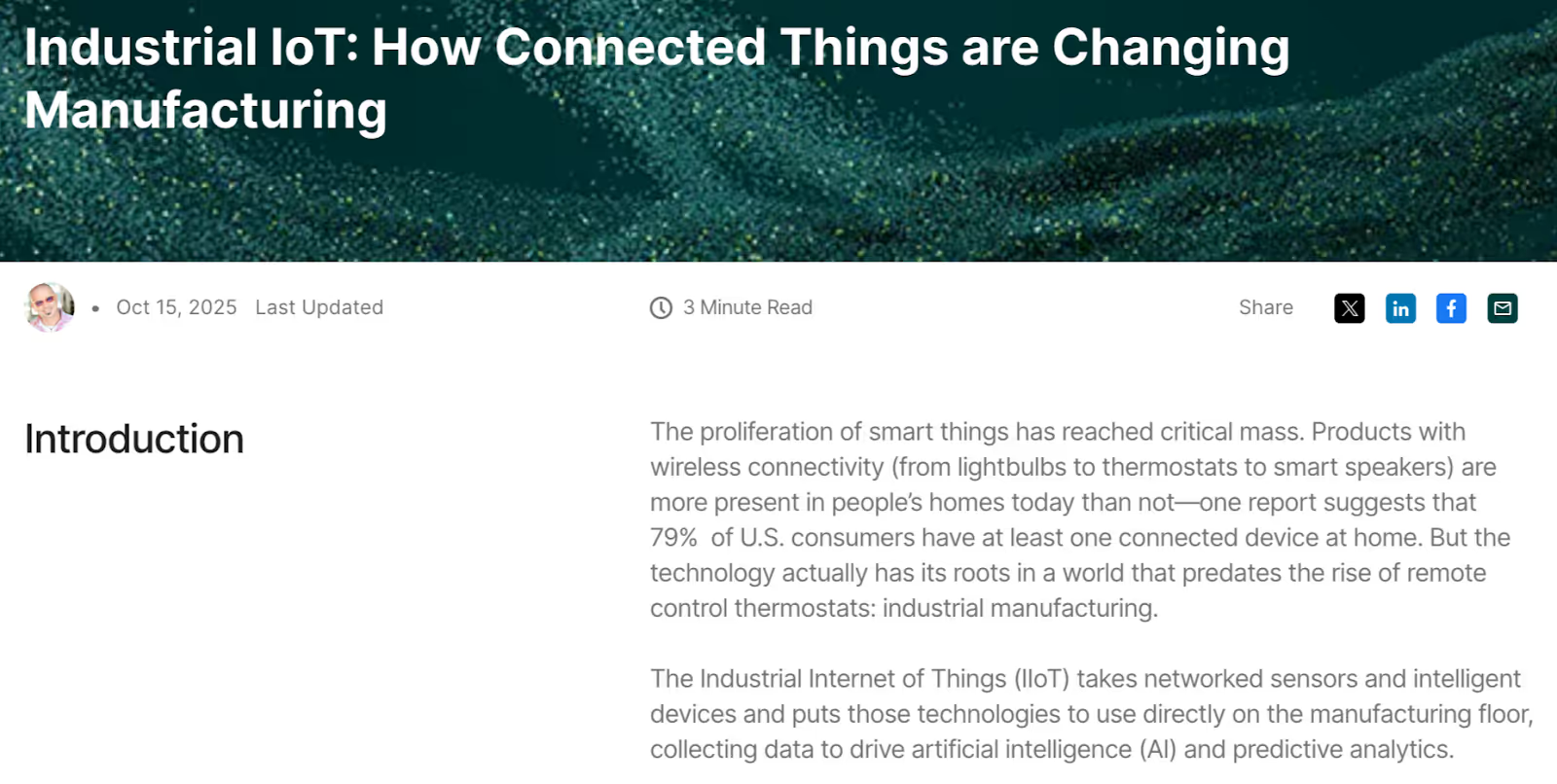
Common Mistakes to Avoid
The Biggest Content Strategy Pitfalls
Pitfall #1: Content Fragmentation
Creating content in silos kills effectiveness. When different teams or individuals create content without coordination, you get redundancy, gaps, and inconsistent messaging. Your blog might say one thing while your service pages say another. Regular content planning meetings and shared calendars prevent this fragmentation.
Pitfall #2: Missing Consideration Stage Content
Ignoring the consideration stage leaves a massive gap in your buyer's journey. Too many B2B sites jump from problem awareness straight to "buy now" without helping buyers evaluate their options. Being too technical too early overwhelms readers who aren't ready for deep details. Save the technical specifications for later-stage content when buyers need that level of detail.
Pitfall #3: Overemphasizing Features
Focusing on features over benefits is a classic B2B mistake. Your industrial equipment might have impressive specifications, but buyers care more about reduced downtime and lower maintenance costs.
Pitfall #4: Letting Content Go Stale
Not updating old content makes your site look abandoned and raises questions about whether information is still accurate.
Pitfall #5: Neglecting the Mobile Experience
Mobile optimization can't be an afterthought when many B2B buyers research on phones during commutes or between meetings.
Pitfall #6: Failing to Nurture Leads
Neglecting email nurture sequences means losing touch with prospects who aren't ready to buy today but might be perfect customers next quarter.
How to Stay Buyer-Focused
Talk to Customers
Regular customer interviews keep your content grounded in real needs, not assumptions. Ask customers:
- About their buying journey
- What information they needed
- What was missing
Align With Sales
Sales team collaboration ensures your content addresses actual objections and questions that come up in real conversations. Your sales team talks to prospects daily; their insights are invaluable for content planning.
Track Competitor Content
Competitor content analysis helps you identify gaps and opportunities. Determine:
- What are they covering that you're missing?
- More importantly, what are they missing that you could own?
Continuous testing and refinement based on data ensures your content strategy evolves with your buyers' needs.
Related Resources:
Conclusion: Your Next Steps for B2B Success
Quick Wins to Start Today
You can begin improving your content strategy immediately with a few simple steps:
- Audit your existing content by buyer's journey stage to see where gaps exist
- Identify your three biggest content gaps that are costing you opportunities
- Create one piece of awareness-stage content addressing a common problem
- Add clear CTAs to guide visitors to the next logical piece of content
- Set up basic analytics tracking to measure content performance
The Long-Term Vision
Building a content library that sells 24 hours a day, 7 days a week transforms your business. Your B2B website becomes a tireless sales assistant that educates, nurtures, and converts prospects while you sleep. By becoming the trusted resource in your industry, you shift from chasing prospects to attracting them.
This approach is ideal because it:
- Shortens your sales cycle since prospects arrive better educated and further along in their journey
- Creates predictable pipeline growth since you're consistently attracting and nurturing new prospects
- Positions your company as the obvious choice when buyers are ready to make a decision
Final Thoughts
Remember that B2B buyers are still humans with real challenges, pressures, and goals. They appreciate content that respects their intelligence while making complex topics accessible. Start small with one piece of truly helpful content, then build from there. Every piece of valuable content you create is an investment in your company's future growth.
The path from awareness to decision isn't always linear, and buyers might revisit stages multiple times. Your content strategy should support them wherever they are in their journey, providing value without pressure. When you get this right, your content becomes your most powerful sales tool, working continuously to build trust, demonstrate expertise, and guide buyers toward choosing you.
